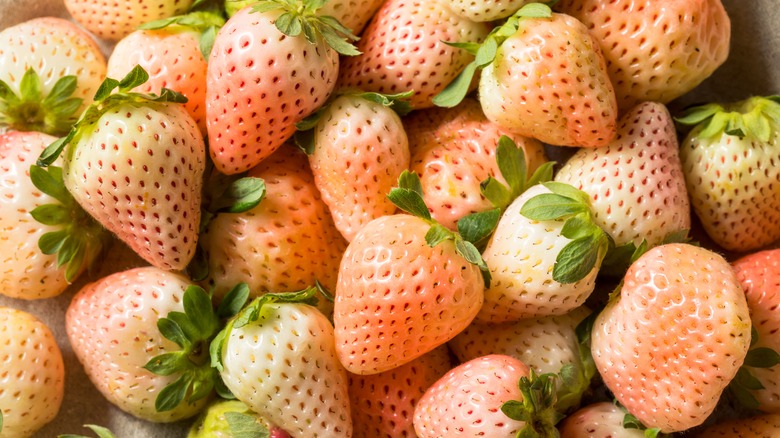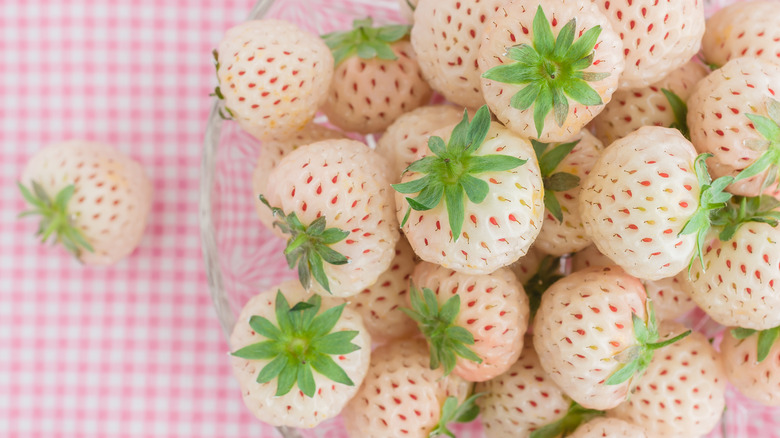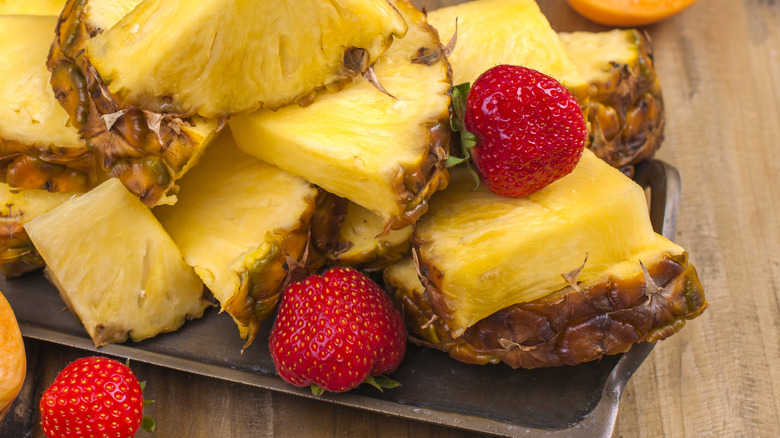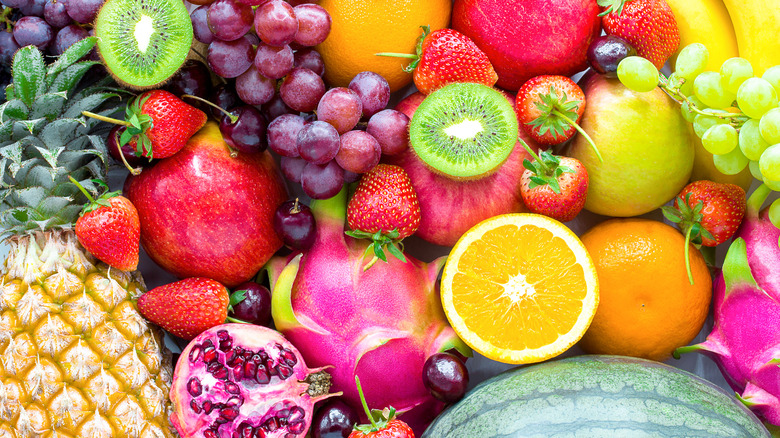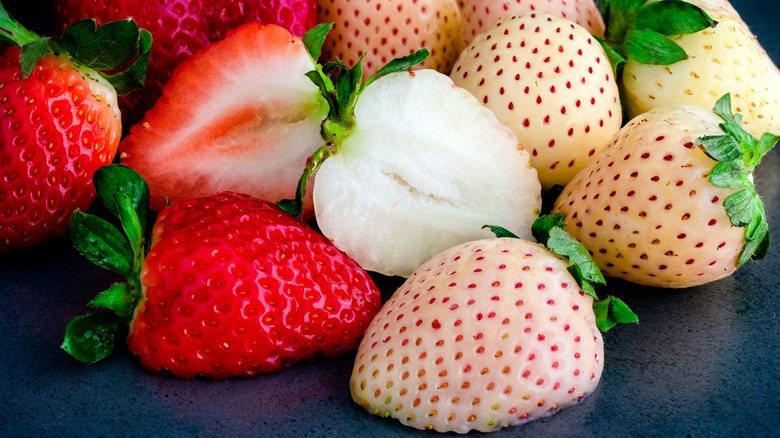The Pale Pink Strawberry Variety With A Slightly Tropical Flavor
Strawberries tend to be equated with a few things: Summer, when the berries are sweet, delicious, and perfectly ripe, and Valentine's Day (which is ironically in winter) because the fruits are sweet, goes well with chocolate, and are typically red and shaped roughly like a heart. Consumers often judge the quality of their strawberries by how red they are; for example, we assume that a strawberry that is deep red from tip to stem will be sweet, while those showing a lot of white will be under-ripe and bitter. But many modern varieties of strawberries have thrown people for a loop due to their obvious lack of red color.
Driscoll's Rosé strawberries are meant to be either pale red or dark pink in color, and white strawberries have made their way from local farmers markets to fine-dining restaurants. Varieties like these have shown strawberry fans that, contrary to popular belief, good strawberries need not be associated with red at all. Allrecipes notes that there are around 50 types of white strawberries in the world, the most well-known and popular being the Jewel varietal, which hails from Japan. Many of these species appear so similar that you might not know one from the other, including a pale strawberry that is sometimes white but is also often a shade of pink.
Behold, the pineberry
Upon first inspection of the pineberry, it appears that the colors of a classic strawberry have been swapped: The flesh is a creamy white or pale pink, and the seeds are bright red, making for a stunning piece of fruit. But Mother Nature didn't make a mistake here; the fruit is a deliberate crossbreed between a native strawberry and a Chilean type of strawberry, per SF Gate.
Wish Farms, a berry producer out of Florida who coined the term "Pink-A-Boo Pineberries" for their crop, explains that cultivated white berries were initially discovered in South America in the 1700s. Eventually, these were crossbred with wild European strawberries, which created the red variety with which Americans are most familiar. Their pineberries came from the University of Florida, where developers crossed a Japanese white strawberry and a Florida red strawberry. Garden Culture Magazine explains that pineberries cannot be grown from seeds and that they must, in fact, continue to be crossbred. Planting seeds from pineberries will actually produce a completely different variety of strawberries!
What do pineberries taste like?
You may have guessed from its name, but pineberries are described as having the flavor and aroma of pineapple. Wish Farms calls them "refreshing with a hint of tropical flavor." They do still taste like strawberries but have also been described as having pear and apricot notes, and they are less acidic than red strawberries. They have a soft texture, and the internal flesh is the same white hue as on the outside.
Because they do taste like strawberries, with maybe a bit more flair, they can be used in anything that calls for strawberries. From smoothies to baked goods and cocktails to garnishes, pineberries are tasty and unexpected accompaniments to a number of recipes. Don't forget that strawberries (and thus pineberries) don't have to be limited to sweet dishes and desserts. They are wonderful in salads, on top of bruschetta, roasted and jammed for a sauce for meats, and added to cheese boards.
Are pineberries good for you?
The short answer is "yes." Their nutritional value is similar to classic red strawberries, making them perfect for a low-calorie snack. Blend of Bites mentions that pineberries contain free radical-fighting antioxidants, and that they are full of vitamins A and C, energy-producing carbohydrates, and fiber which helps you feel full.
In addition, they contain manganese, which is not naturally produced in the body, and must be obtained by diet, according to Medical News Today. Manganese promotes bone health, the production of antioxidants, and encourages healthy blood sugar levels. The potassium found in pineberries is also incredibly beneficial. Healthline explains that potassium is a mineral that acts as an electrolyte and may help reduce blood pressure, regulate water retention, and is key in maintaining a healthy nervous system. You've heard for years how important it is to eat plenty of fruits and vegetables, and the nutrition in pineberries is just one example of why these natural foods are so vital for a healthy body.
How are pineberries different?
The difference in appearance to red strawberries is obvious, but pineberries still bear a striking resemblance to varieties of white strawberries. But the way the two develop their color couldn't be more different. According to Wish Farms, pineberries are grown outside in the sunshine. The pale pink hue comes directly from the sun itself, but the berry naturally lacks Anthocyanin, which gives strawberries their red color. Meanwhile, Allrecipes explains that white strawberries are grown with restricted sun exposure to maintain their pale hue. Wish Farms also notes that their pineberries are only picked at the peak of ripeness, as they will not continue to ripen once they are harvested.
Driscoll's pale strawberry varietals, Rosé and Tropical Bliss, boast flavor notes of peach, pink lemonade, passionfruit, and pineapple, while pineberries maintain their strawberry flavor with soft hints of pineapple. Even Chile's pricey white strawberry differs, with a delicate, even floral taste profile. Pineberries are not as difficult to find as they once were, but they are still seasonal, so don't expect to find them at your local market year-round. According to a 2022 article from Elite Daily, pineberries could be found at several supermarkets for less than $5 per pack, which is far less expensive than many white strawberries on the market.
